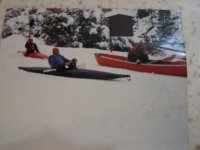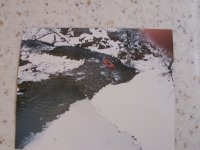I started out paddling flatwater lakes in Ontario's Quetico Park in the mid 1960s, then got interested in whitewater sometime in the early 1970s after a short stint trying out canoe marathon racing. That training stuff for racing is a lot of work. Whitewater turned out to be more fun for me. I did some slalom racing early in that, but again that word "training" reared its ugly head, and so much for that stuff. Just running rivers was way more interesting. The Quetico and other flat stuff was open canoe, and we still did some of that, but most of the whitewater work was decked C-1 and some decked C-2. I'd occasionally borrow a short 14-foot fiberglass solo open canoe from a friend and do some OC-1 whitewater to make easier runs more interesting. I didn't purchase a solo open canoe of my own until late 1979, a Perception HD-1 in Royalex. A great boat, designwise, but a poor ABS laminate schedule as it turned out as I quickly beat the crap out of it. I replaced it with the aforementioned ME. Also as mentioned, that was the boat I used on my first Canyon run.
I think I ran clean on that run, though I remember I rolled once in Hance, mile 76. We all ran Lava Falls, mile 179, on a left route as the water was high and just huge waves except for that monster hole top center. That trip our water was "green," meaning clear, down to Dubendorf Rapids, mile 131, so we got to enjoy a stop way upstream at the Little Colorado, mile 62, in its bright turquoise coloration. An early monsoon rain while camped at Stone Creek, mile 132, just below Dubendorf Rapids, turned the river a blood red color, which changed to the more commonly seen dirty brown later that day.
We had more rain later that run, with one couple almost getting flashflooded in Matkatamiba Canyon, mile 148. Luckily they were at a spot where they could climb above the floodwaters when the creek started its quick increase in flow. There were waterfalls coming over the edge of the main canyon rim everywhere we looked that day. I do remember some relatively quiet places on the river where there was distance between the big drops. Sometimes the rush of the current could be heard, but no roar from drops, and to me it was quite peaceful in those spots.
We witnessed rockfalls several times on our trips, but weren't in any danger from them. One memorable one was just in front of us while hiking the trail at Deer Creek Falls (mile 136). Three big Volkswagen Beetle-sized boulders came down from the cliff above, bounced across the trail, and fell into the creek many feet below after a furious rain and hailstorm we'd just had. I may have mentioned in another post somewhere else that a friend on a later trip was in the Canyon during an earthquake at night, and there were rocks falling from the rim and walls all around them, but no one could see anything at 2 a.m. Stand there and hope. A couple of backpackers were killed somewhere on either the South Bright Angel Trail or the South Kaibab Trail, but no river runners were even hurt. One of the big commercial raft trips had their kitchen setup smashed flat by a huge boulder. Think of it as boring old geology finally in action.
Other trips I was on were similar in many respects, but different, also. The river flows were less, as conservation efforts had mandated less fluctuation in dam releases, so the high flows were usually now just double the low flows, where on my first run the daytime releases were sometimes five or six times what was released during night. We went from 6,000 cfs up to 25,000 and 30,000 cfs, and even higher. Pro rafters said the flow at Lava for our run was probably 35-36,000 cfs. After the mandate I think this averaged about 20,000 cfs in the daytime, and 10,000 at night. It could have been less, like 8K and 16K, or even more at times, 12K and 24K.
And, of course, water takes time to get downstream, so the surge 50 or so miles downstream is about 12 hours different than at Lee's Ferry, which is only 15 miles below the Glen Canyon Dam. Somewhere down between Nankoweap at mile 52 and the mouth of the Little Colorado at mile 62, the water starts going up at 8 p.m. instead of 8 a.m., and starts its way down around 5 in the morning, so you're paddling or rowing on low water during that day. It's like tides moving down the river, up, down, up down. With the lesser fluctuation differences it's less of a hassle than it was on my first run but still noticeable. The big flows back then were really fun, and the real lows sometimes a pain. I don't know what's going in dam releases now, haven't kept up with the Canyon politics recently.
Also like Johnny5, I ran drops every which way, forwards, backwards, upside down, and swimming. All my swimming was at Lava Falls, as I wanted to do the "Bubble Line" run on the right there. I did it, but not successfully -- swam three times. I shoulda stayed left. Oops, I remember swimming one time while surfing the big waves at Hermit (mile 95) one year, don't remember now which trip it was. Get back in the boat and back up and do it some more.
Like Johnny5, I volunteered for the pottymeister job (or "head man" or other similar appellations) for the trips I was on as it excused me from cooking duty, which I detest and am no good at. With the river mileages noted above, I'm obviously into the maps, though, unlike Johnny5. I want to know where we are and what there might be to do if we can camp appropriately, which isn't a given. There is a lot of competition for camps in summer, and the good one you want is in sight, but two big motor rigs buzz by you and grab it, forcing you somewhere else downstream.
A lot of the books I read, often fictional trips in the Canyon, emphasize the solitude. It's not always that way. During the late spring, summer, and into fall peak seasons there might be days you see few others, but some days you might see 200-300 people, especially at places like Havasu Creek, mile 157. There are advantages to the winter runs like Johnny5 and Uncle Sqwid did. More days on the water, but they're needed as the days are shorter, too.
It can be colder in the Canyon in winter, but there are usually a lot of warm days, also. Summer temperatures at the bottom can be very hot. I've seen 118 degrees F. (more than 47 C.) displayed on a thermometer in the afternoon heat. People tend to congregate at the water's edge then, as it's cooler there. Water out of the dam is I think about 46 degrees F, and it warms up slowly, but is still only about 65 degrees at Diamond Creek, where I've always taken out at mile 225.
All of my trips were raft supported, I and another couple of kayakers basically along on a raft trip, but paddling our own craft, almost all our gear in the inflatables. We always had a full complement of participants on our trips, which was 16 people on a private permit. I think this changed after the waiting list was phased out, but I'm not sure. I just haven't kept up with it. Sometimes we had people hiking out at Phantom Ranch (mile 88) and others hiking in there to replace them. We just felt that such a trip was too good to not be shared with as many friends as we could.


